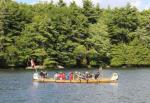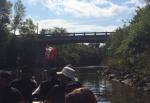By LCol Claire Bramma, RCE, CO Mapping and Charting Establishment
This article is an amplification of Don Cooke’s article “The Royal Sappers & Miners Cemetery, Newboro” published in CHIMO in April 2016.
From 16 to 22 September 2016 a 15-person crew of former and current Royal Military College (RMC) cadets paddled a war canoe from Ottawa to Kingston along the historic Rideau Canal waterway. Our crew is known as “La Chasse Galerie” and represents a blend of Franco-Canadien and First Nations traditions and this year was the fifth edition of the trip since its inception in 2000. The aim of the canoe trip is to raise funds for the RMC sports programs so that our future leaders may benefit from the experience of athletic excellence while at the colleges. Tipped off by Cooke’s article and as a serving Royal Canadian Engineer, I could not pass up the opportunity to visit the Royal Sappers and Miners Cemetery at Newboro on 20 September.
The site of the Newboro lock represents a literal and figurative watershed for the realisation of the Rideau Canal waterway. Recognising the toll that both the working conditions and disease were having on those constructing the channel at Newboro, Royal Engineers were instrumental in exploiting the surrounding landscape and water features to save human lives and to meet construction deadlines. First of all, the context for the challenging task to cut a mile-long channel at Newboro will be described. Secondly, the adaptation of the project will highlight a perceived change of mindset among the Royal Engineers. Finally, I will outline some relevant takeaways.
Between 1829 and 1831, the 7th Company, Royal Sappers & Miners worked on the construction of the Rideau Canal in the Johnstown District, now known as town of Newboro. Captain Savage was the commander of 7th Company which consisted of three Lieutenants (Benjamin, Briscoe, and Simon) and 57 sappers. Working alongside 7th Company were approximately 250 labourers (a mix of locals and Irish settlers) as well as two Royal Engineer Captains (Cole and Gale) who oversaw technical aspects of the construction. This site is a very important location to the Rideau Canal system because it is the highest point along the waterway, where the water flows north to Ottawa through Upper Rideau lake and south to Kingston via Newboro and Clear lakes. Rideau Canal mastermind Colonel By recognised a requirement to excavate a mile-long channel at Newboro in order to create a passageway for vessels and to contribute to the regulation of water flow. Due to the large extent of the project, it was completed under direct military supervision.
The man-made channel at Newboro was built by hand using simple tools and basic borehole techniques. Soil excavation was done using picks and shovels, with wheelbarrows and a small number of oxen employed for transportation to dumping areas. Once the trees and soil were removed, the most significant challenges were encountered during the excavation of the Precambrian shield. Cutting into this hard rock was achieved by drilling narrow holes (by hand) which were then filled with simple gunpowder (three parts nitrate to one part of a sulphur and charcoal mixture). The holes were tamped and the charges were set off using slow burning fuses. This proved to be a time-consuming process which was compounded by the fact that the excavated rock had to be broken up into smaller pieces manually using hammers and iron bars. The rocks were then removed by wheelbarrow or simple hand hoists. This gruelling task was made even more difficult in summer of 1830 due to the spread of malaria among the workers and their families. At the time of this project, approximately 500 people were garrisoned at Newboro housed in over 30 different buildings. Based on historical records there are six Royal Sappers and Miners who died and were buried on-site between 1829 and 1831. The fallen Sappers are identified as Thomas Simmons, Marshall Darling, Joseph Stuart, John Sanderson, John Blackwood, and John Richard. Many other civilian labourers were subjected to injury, illness, and even death.
The Royal Engineer Captains assigned to 7th Company (Cole and Gale) acknowledged this deteriorating situation and looked for mitigation. To minimise the amount of excavation required to achieve a navigable channel, they endeavoured to build a dam downstream in order to raise the water level. They designed and initiated the construction of a dam a few kilometres to the north, and subsequently, the water level was successfully raised five feet which lessened the need for the Newboro channel to be excavated deeper than necessary. Today, this dam is paired with a lock that is known today as The Narrows. The Royal Engineers successfully exploited the local hydrography to reduce the excavation requirements and therefore save human lives as well as time.
This change in approach for the engineering of the Rideau Canal represented here at Newboro parallels the change in water flow along the waterway, which is certainly noticed by anyone negotiating the canal by canoe. On Day 5 of our trip, La Chasse Galerie took an extended lunch break at the Newboro Lock to appreciate the historical significance of the site. As we paddled through the man-made channel, the jagged rock along the shoreline served as reminders of the 7th Company’s toil, while the tranquil tree-lined route allowed us to appreciate the birds and vegetation native to the Rideau. When we arrived at Newboro Lock, we were greeted by members of the Royal Sappers & Miners Cemetery Committee, notably Don Orr (secretary) and Joan Wright (chairperson), as well as former Canadian military engineers Max Christie and Jim Murphy.
Following a short walk down the trail, we arrived at the site of the cemetery where the six fallen Sappers are acknowledged to have been buried. At the cemetery, there were several members from the committee as well as former military engineers. We also had the opportunity to meet the Mayor of Rideau Lakes Township, Ron Holman and local historian Neil Patterson. Mr. Patterson has done extensive research concerning several burial grounds throughout Rideau Lakes and proved to be a wealth of knowledge during our visit. We also learned that the committee is working on identifying additional grave sites as well as locations of the various buildings that comprised the garrison occupied by 7th Company and its workers.
Newboro and the Rideau Lakes Township clearly recognise the importance of the Rideau Canal and demonstrate pride in their history. Since 2014 the Royal Sappers and Miners Cemetery Committee have cleaned up and restored the abandoned burial site. The committee is currently working with the Last Post Fund-Ontario Region to design and install an appropriate commemoration monument to honour the Sappers who died at the site, hopefully in 2017 to coincide with Canada’s 150th celebrations. The Last Post Fund, supported by Veterans Affairs Canada and private donations, includes in its mandate support for initiatives to honour the memory of Allied Veterans and offers assistance through the Unmarked Grave program. Consideration is also being given as to how to recognise the efforts and sacrifices made by the civilian labourers at the Newboro Isthmus.
In conclusion, Newboro exemplifies the leadership challenge faced by the Royal Engineers throughout the construction of the Rideau Canal. In this situation, Captains Savage, Cole, and Gale were able to inspire a diverse group of workers to get the job done, despite extreme working conditions and disease. More importantly, the Engineers sought an innovative solution to build the dam at The Narrows in order to minimize the amount of excavation required to build the Newboro channel. Newboro also represents how today’s generation is making great strides to honour the past and those who gave their lives during the building of the Rideau Canal. Finally, my visit reinforced my appreciation for how the Royal Engineers form a significant part of the history of both the Canadian Military Engineers as well as Canada.
CHIMO
For more information:
Legget, Robert. “Rideau Waterway” revised edition, University of Toronto Press (1972).
RMC Foundation. http://www.rmcfoundation.ca/index.php/enhancing-excellence/athletics/la…;




